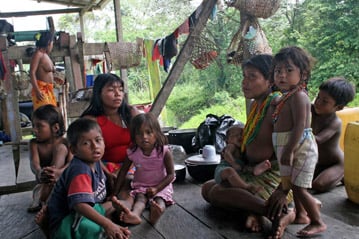Indigenous Colombians flee violence in remote homelands
Indigenous Colombians flee violence in remote homelands
Humanitarian teams have reached some 200 indigenous people who have arrived in remote villages in south-west Colombia after fleeing violence on their collective territory. On Tuesday, UNHCR called for a full investigation into the reported killings of 17 Awá indigenous people in Telembi Tortugaña, in one of the most isolated and conflict-ridden parts of the country. Two humanitarian teams, including UNHCR, other UN agencies and NGOs, arrived yesterday (Thursday) in the villages of Samaniego and Buenavista, where around 200 Awá people have managed to take refuge.
The 114 Awá people who reached the village of Buenavista are in very poor health after making the long and hazardous journey from their territory. There are many landmines in the area. Many of the children show signs of chronic malnutrition. There is very limited infrastructure in Buenavista to receive them. Officials from the state body responsible for assistance for displaced people have arrived in the area and will start coordinating delivery of humanitarian supplies. Humanitarian assistance is in place in Samaniego, where 68 Awá had arrived by Thursday afternoon.
The Awá authorities have requested that all the displaced be moved out of the area as soon as possible and taken to a safer location further south, where the local Awá community is organizing itself to receive them.
Despite the efforts of the authorities to reach the site of the reported massacre, so far no civilian state institutions have managed to enter the area, and the bodies of the 17 presumed dead have not been found. On Wednesday, there were local reports that up to 13 more people had been killed on another collective territory known as El Sandal.
UNHCR reiterates its call for a full judicial investigation into the reported murders. It again asks all parties to respect international humanitarian law and urges the Colombian government to fulfil its obligations to protect civilians.
Located on the Pacific Coast along the border with Ecuador, the department of Nariño is one of the regions of Colombia most affected by the civil conflict. For the past two years, it has had the highest rate of forced displacement in the country. The Awá are the largest indigenous group in that part of Colombia and are suffering from harassment, threats, murders and forced displacement as a result of the presence of armed groups on their territory.
The UNHCR field office in Nariño has been working closely with the Awá people, who like many Colombian indigenous groups have been struggling for years to keep out of the country's internal conflict. With 21,000 people, the Awá are the largest indigenous group in Nariño. They are one of 87 different indigenous groups in Colombia. More than a third of these groups are at risk of extinction, largely as a result of armed conflict and forced displacement.
More than 300,000 people were displaced in Colombia in 2007 and preliminary 2008 figures show a similar trend, bringing the total number of registered internally displaced people to more than 2.8 million.
With 12 offices in Colombia, UNHCR works with the government to help it fulfil this protection duty and with indigenous organizations all over the country.





